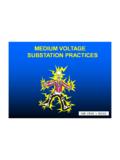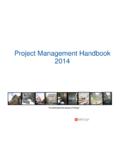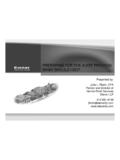Transcription of LIFTING TACKLE INSPECTIONS – WHY, HOW AND BY …
1 Director: J. D. van Zyl Tel: +27 11 412 2918 Fax: +27 11 692 3826 Cell: +27 82 880 5678 e-Mail: Website: Box 6545, Greenhills, Gauteng, South Africa, 1767 Reg. No. 2008/005840/07 A Level 3 B-BBEE Entity LIFTING Machinery Entity LME No 330 An ISO 9001:2008 Certified Company 456104 QM08 LIFTING TACKLE INSPECTIONS WHY, HOW AND BY WHO? INTRODUCTION LIFTING TACKLE , also referred to as loose LIFTING gear, must be inspected at regular intervals to ensure safety in the work place, as well as for the user to be legally compliant. Additional legal requirements are proper sling and component traceable markings, correct certification, keeping of proper records as well as storage.
2 It is also a legal requirement to only use LIFTING TACKLE that conforms to acceptable quality standards such as SANS, DIN, EN or other ISO aligned standards. WHY INSPECT? The OHSA LIFTING equipment requirements are specified in DMR 18. inspection requirements are covered in DMR (e) which specifies visual INSPECTIONS of LIFTING TACKLE in use at regular intervals not exceeding three month periods. Although the LIFTING Equipment Regulations of the MHSA do not specify INSPECTIONS parameters, it is up to Mine Management to include these requirements in their written operating procedures and implement accordingly.
3 Some users inspect monthly or even weekly, but three months is the accepted norm, not only for LIFTING TACKLE but also for hoists, including chain blocks, lever hoists and electric or air hoists. HOW TO INSPECT INSPECTIONS must be conducted in accordance with scheduled maintenance schedules and procedures. The results of these INSPECTIONS must be recorded properly in an inspection register or file, which needs to be kept on the user's premises, and available for scrutiny by auditors or other interested parties. These registers must contain proper check lists that specify what the Inspector must look for on each separate item of LIFTING TACKLE that he inspects.
4 It is not good enough to simply put a tick mark or cross on a checklist or, simply state suitable for use, or not , on a generic check list. Apart from the inspection Register, the User also needs to have an up to date Inventory of all LIFTING TACKLE on site, as well as Certificates of Test or Certificates of Conformance, for each item in use. WHO DOES THE inspection ? Firstly, LIFTING TACKLE does not have to be inspected by a registered LMI but can be inspected by a contracted service provider, normally a supplier, or an in house appointed Inspector. This person is referred to as the LTI, and should be appointed by management in writing.
5 His appointment should be based on his experience, skills and knowledge of LIFTING TACKLE inspection requirements. It must be stressed that LIFTING TACKLE must not be load tested once it has been put into use. This practice is not recommended as the User is not allowed to subject LIFTING TACKLE to a load in excess of the OEM s WLL. Director: J. D. van Zyl Tel: +27 11 412 2918 Fax: +27 11 692 3826 Cell: +27 82 880 5678 e-Mail: Website: Box 6545, Greenhills, Gauteng, South Africa, 1767 Reg. No. 2008/005840/07 A Level 3 B-BBEE Entity LIFTING Machinery Entity LME No 330 An ISO 9001:2008 Certified Company 456104 QM08 Therefore load testing a sling in use is not recommended and serves no purpose if one considers the applicable factors of safety, which varies from 4:1 for alloy chain, to 7:1 for webbing slings.
6 Lastly, if service provider s LTI's are used, their appointments, from the service provider, should also be scrutinized. Also no SANS exists for testing slings in use. GUIDE TO LIFTING EQUIPMENT TESTING AND INSPECTIONS There appears to be a lot of confusion in the work place, including at major construction sites, Mines and Plants regarding the legal requirements for the inspection and/or testing of LIFTING equipment, which includes LIFTING machines, LIFTING TACKLE , hoists and fabricated LIFTING equipment. 1. Visual INSPECTIONS compared to Examinations A visual inspection is done by "visually checking all visible components" (SANS 500) of a sling or hoist for example, and completing a properly prepared check list.
7 This can be done by a person or inspector appointed in writing by virtue of the person s knowledge, experience and training. An examination is a "detailed study by a competent person in such depth and detail as he considers necessary to enable him/her to determine whether the equipment being examined is safe to remain in use" (SANS 500). This could include stripping a unit and conducting an operational test such as on a hoist. An examination should be done by a LMI or competent appointed technician or artisan. As a start it is common knowledge that all LIFTING machines which are classified according to different Codes in Appendix 12 of the OHSA, DMR, must be load tested (performance tested) at intervals not exceeding 12 months.
8 This load test must be conducted by a DOL registered LME. This actual load test must be conducted, or be supervised by an ECSA registered LMI. The LMI is assessed and found competent by ECSA. The LMI can only test the types of LIFTING machines that he has been registered for as a LMI by ECSA. ECSA do not print the scope of competence of the LMI on his LMI certificate. The only method for the user to establish whether this LMI is competent to load test a specific type of machine is to request a copy of his ECSA confirmation of registration letter which reflects the scope of his competence. Where the MHSA does not specify any issue relating to health and safety, such as OHSA LME/LMI requirements, the requirements of the OHSA DMR 18 apply by interpretation of the MHSA Section 103.
9 The following questions are regularly asked in the work place. Our comments, if not a legal requirement, is provided based on best practice. 2. Who is a Competent Person to conduct examinations, as well as INSPECTIONS of LIFTING Machines? As there is no definition for a Competent Person (CP) in the DMR, one should consider the definition of a CP as it is specified in the OHSA CR as these where published in 2003 and since been updated compared to the DMR which was Director: J. D. van Zyl Tel: +27 11 412 2918 Fax: +27 11 692 3826 Cell: +27 82 880 5678 e-Mail: Website: Box 6545, Greenhills, Gauteng, South Africa, 1767 Reg.
10 No. 2008/005840/07 A Level 3 B-BBEE Entity LIFTING Machinery Entity LME No 330 An ISO 9001:2008 Certified Company 456104 QM08 published in 1993. No recent updates in DMR have mentioned the definition for a CP other than the requirements for an LMI. It is clear that the LMI has to conduct or supervise the periodic actual load testing of LIFTING machines but it is not clear whether the 6 monthly thorough examinations have to be conducted by a LMI. The Draft DMR 2015 mentions a person with knowledge and and therefore would imply that, in future, you would not have to be a LMI to do these thorough examinations.












